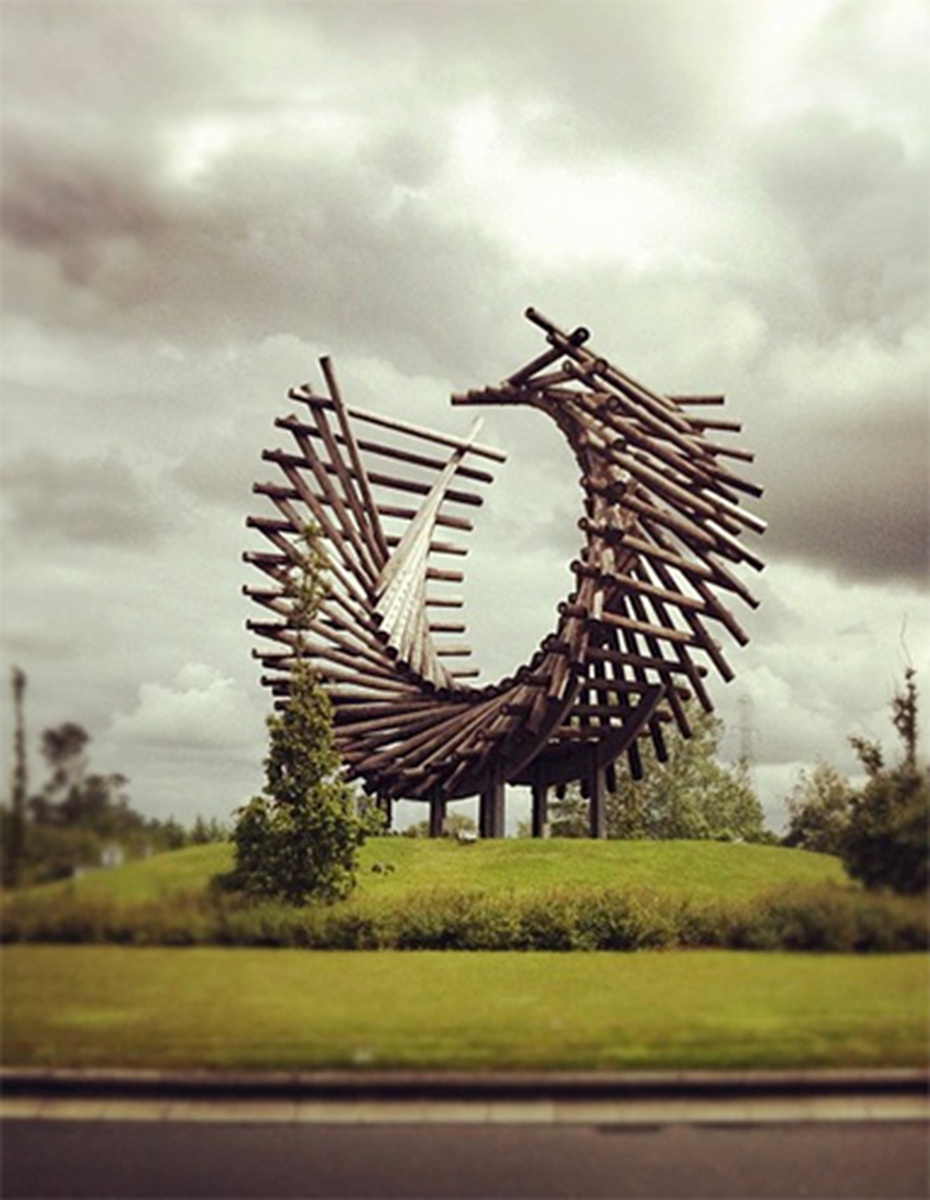Roundabouts
November 2011
Essay by Níall McLaughlin
I’m learning how to drive at the moment. It’s much harder than I had imagined. Some things you just know will be difficult like three point turns or parallel parking, but Ican’t do roundabouts. I didn’t expect this. What could be easier or more natural than circling around a fixed point until your number comes up? You drift in, spin around and drift out. If you’re good at it you can even look out for orbiting cyclists. For some reason I get it wrong every time. I find there is something unnerving about centrifugal force. It is always stronger and stranger than I expect. As soon as Ifeel the deep tidal tug I struggle to resist it. If I keep that up I won’t pass my test.
Orbital motion is deeply embedded in natural systems. Planets and weather patterns are easily drawn from the straight and narrow by involuted forces that send them spinning and spiralling into circular motion. Recent experiments show that we all have a hardwired turning tendency that will lead us into circular paths if we are left without orientation. Yet behind the wheel of a car I rebel intuitively against roundabouts with their endless, pointless turning.
I was surprised to learn that Eugene Henard, a Frenchman, invented the roundabout. Ihad always imagined that they were part of the geology of Southern England. In the country around Hatfield there are roundabouts every few hundred yards. It must look like chain mail from space. In fact it’s all very recent. A friend of mine saw Britain’s first mini-roundabout being built in Hemel Hempstead in the early 1970s. I was delighted to hear that it caused chaos at its opening. No one could work the damn’ thing. There were backups, collisions, shunting accidents – divine chaos! Now drivers hardly notice them anymore.
The principle of roundabouts is that they allow everyone to go faster together by restricting the speed of each individual. This is very democratic. No wonder the Americans hate them. Imagine that great picture of the American West, the one on The Eagles’ album cover. Aroad runs straight out into perspective, it tracks straight between mesas and buttes along miles of deep red sand. You know it stretches right out to the sea away over the horizon. Now put a roundabout on it. This is the point. In every driver’s soul there is a dream of travelling outwards into space. The landscape rolls by endlessly. The roundabout is the death of that dream. It is a very civilised vice put onto a part of our deepest instinct about space and landscape. The people of Hatfield can never travel a line again.
There were no roundabouts in Ireland when I left. We were still in the Wild West. I visited the deep tundra of County Mayo recently. The local MP has talked someone into providing a job lot of roundabouts for the region. They crop up everywhere. My driver blamed the European Union. “They came here with all of their money for roundabouts and they put a sculpture on every bloody one. Sculptures and roundabouts are all they ever gave us.” There is an uncanny echo of this on each roundabout which has a big sign beside it, announcing that it was built using EUstructural funds. The dark blue notices carry the emblem of the European Union, a circle of yellow stars orbiting a void. I wonder if they repaint the signs every year adding stars around an ever-enlarging blank space.
I have become a connoisseur of Irish roundabout art. The aim is to make something from folded rusting steel plate that could be a mountain range, or a cloud, or the sail of a ship. It is important to cover the options but leave room for interpretation. Roundabout artists have a strong urge to conjure suggestions of open landscape and freedom. There might be something placatory about these folded totems. But a roundabout on a road is like a bridge over a river. Once it’s done you can’t regain the essential spirit of the landscape you have lost.
The Middle East has become the spiritual home of the roundabout. It is claimed that Jeddah has more of them than anywhere on earth. They even boast that they hold the record for the largest number of roundabout accidents – a staggering one per minute! Now this gets my pulse racing. And the art in the central circles puts County Mayo in the shade. There are giant globes, marooned ships, grotesquely inflated bicycles and a huge hand clutching a traditional-style perfume bottle. My partner was raised in Kuwait City and she remembers day-trips to a landmark called the Pepsi Cola Roundabout. This is a great name for a place. It is both everywhere and nowhere. We can at least infer that it is somewhere on earth. If Iever really go into orbit, I’m going to look for it from space.
